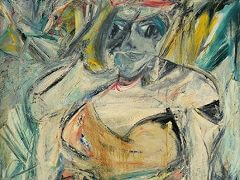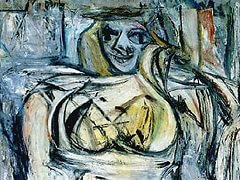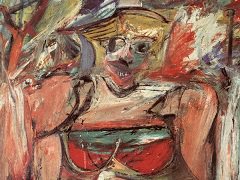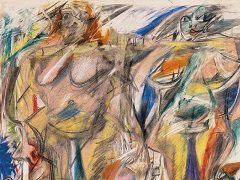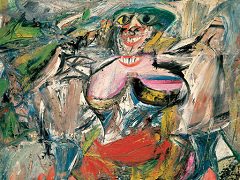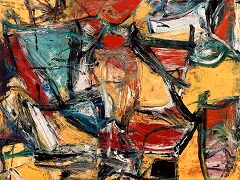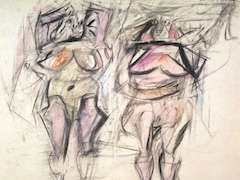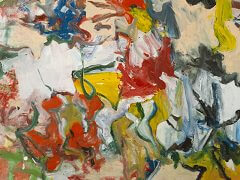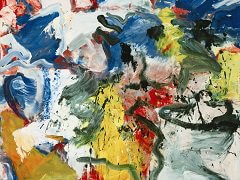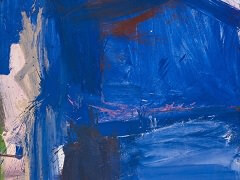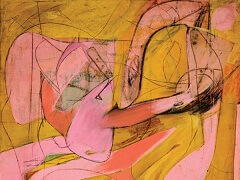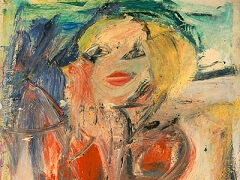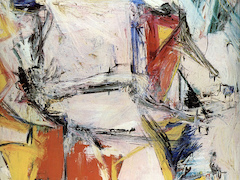What Abstract Art Means to Me by Willem de Kooning
The first man who began to speak, whoever he was, must have intended it. For surely it is talking that has put "Art" into painting. Nothing is positive about art except that it is a word. Right from there to here all art became literary. We are not yet living in a world where everything is self-evident. It is very interesting to notice that a lot of people who want to take the talking out of painting, for instance, do nothing else but talk about it. That is no contradiction, however. The art in it is the forever mute part you can talk about forever.
For me, only one point comes into my field of vision. This narrow, biased point gets very clear sometimes. I didn't invent it. It was already here. Everything that passes me I can see only a little of, but I am always looking. And I see an awful lot sometimes.
The word "abstract" comes from the light-tower of the philosophers, and it seems to be one of their spotlights that they have particularly focussed [sic] on "Art." So the artist is always lighted up by it. As soon as it - I mean the "abstract" - comes into painting, it ceases to be what it is as it is written. It changes into a feeling which could be explained by some other words, probably. But one day, some painter used "Abstraction" as a title for one of his paintings. It was a still life. And it was a very tricky title. And it wasn't really a very good one. From then on the idea of abstraction became something extra. Immediately it gave some people the idea that they could free art from itself. Until then, Art meant everything that was in it - not what you could take out of it. There was only one thing you could take out of it sometime when you were in the right mood - that abstract and indefinable sensation, the esthetic part - and still leave it where it was. For the painter to come to the "abstract" or the "nothing," he needed many things. Those things were always things in life - a horse, a flower, a milkmaid, the light in a room through a window made of diamond shapes maybe, tables, chairs, and so forth. The painter, it is true, was not always completely free. The things were not always of his own choice, but because of that he often got some new ideas. Some painters liked to paint things already chosen by others, and after being abstract about them, were called Classicists. Others wanted to select the things themselves and, after being abstract about them, were called Romanticists. Of course, they got mixed up with one another a lot too. Anyhow, at that time, they were not abstract about something which was already abstract. They freed the shapes, the light, the color, the space, by putting them into concrete things in a given situation. They did think about the possibility that the things - the horse, the chair, the man - were abstractions, but they let that go, because if they kept thinking about it, they would have been led to give up painting altogether, and would probably have ended up in the philosopher's tower. When they got those strange, deep ideas, they got rid of them by painting a particular smile on one of the faces in the picture they were working on.
The esthetics of painting were always in a state of development parallel to the development of painting itself. They influenced each other and vice versa. But all of a sudden, in that famous turn of the century, a few people thought they could take the bull by the horns and invent an esthetic beforehand. After immediately disagreeing with each other, they began to form all kinds of groups, each with the idea of freeing art, and each demanding that you should obey them. Most of these theories have finally dwindled away into politics or strange forms of spiritualism. The question, as they saw it, was not so much what you could paint but rather what you could not paint. You could not paint a house or a tree or a mountain. It was then that subject matter came into existence as something you ought not to have.
In the old days, when artists were very much wanted, if they got to thinking about their usefulness in the world, it could only lead them to believe that painting was too worldly an occupation and some of them went to church instead or stood in front of it and begged. So what was considered too worldly from a spiritual point of view then, became later - for those who were inventing the new esthetics - a spiritual smoke-screen and not worldly enough. These latter-day artists were bothered by their apparent uselessness. Nobody really seemed to pay any attention to them. And they did not trust that freedom of indifference. They knew that they were relatively freer than ever before because of that indifference, but in spite of all their talking about freeing art, they really didn't mean it that way. Freedom to them meant to be useful in society. And that is really a wonderful idea. To achieve that, they didn't need things like tables and chairs or a horse. They needed ideas instead, social ideas, to make their objects with, their constructions - the "pure plastic phenomena" - which were used to illustrate their convictions. Their point was that until they came along with their theories, Man's own form in space - his body - was a private prison; and that it was because of this imprisoning misery - because he was hungry and overworked and went to a horrid place called home late at night in the rain, and his bones ached and his head was heavy - because of this very consciousness of his own body, this sense of pathos, they suggest, he was overcome by the drama of a crucifixion in a painting or the lyricism of a group of people sitting quietly around a table drinking wine. In other words, these estheticians proposed that people had up to now understood painting in terms of their own private misery. Their own sentiment of form instead was one of comfort. The beauty of comfort. The great curve of a bridge was beautiful because people could go across the river in comfort. To compose with curves like that, and angles, and make works of art with them could only make people happy, they maintained, for the only association was one of comfort. That millions of people have died in war since then, because of that idea of comfort, is something else.
This pure form of comfort became the comfort of "pure form." The "nothing" part in a painting until then - the part that was not painted but that was there because of the things in the picture which were painted - had a lot of descriptive labels attached to it like "beauty," "lyric," "form," "profound," "space," "expression," "classic," "feeling," "epic," "romantic," "pure," "balance," etc. Anyhow that "nothing" which was always recognized as a particular something - and as something particular - they generalized, with their book-keeping minds, into circles and squares. They had the innocent idea that the "something" existed "in spite of" and not "because of" and that this something was the only thing that truly mattered. They had hold of it, they thought, once and for all. But this idea made them go backward in spite of the fact that they wanted to go forward. That "something" which was not measurable, they lost by trying to make it measurable; and thus all the old words which, according to their ideas, ought to be done away with got into art again: pure, supreme, balance, sensitivity, etc.
Wassily Kandinsky understood "Form" as a form, like an object in the real world; and an object, he said, was a narrative - and so, of course, he disapproved of it. He wanted his "music without words." He wanted to be "simple as a child." He intended, with his "inner-self," to rid himself of "philosophical barricades" (he sat down and wrote something about all this). But in turn his own writing has become a philosophical barricade, even if it is a barricade full of holes. It offers a kind of Middle-European idea of Buddhism or, anyhow, something too theosophic for me.
The sentiment of the Futurists was simpler. No space. Everything ought to keep on going! That's probably the reason they went themselves. Either a man was a machine or else a sacrifice to make machines with.
The moral attitude of Neo-Plasticism is very much like that of Constructivism, except that the Constructivists wanted to bring things out in the open and the Neo-Plasticists didn't want anything left over.
I have learned a lot from all of them and they have confused me plenty too. One thing is certain, they didn't give me my natural aptitude for drawing. I am completely weary of their ideas now.
The only way I still think of these ideas is in terms of the individual artists who came from them or invented them. I still think that Boccioni was a great artist and a passionate man. I like Lissitzky, Rodchenko, Tatlin and Gabo; and I admire some of Kandinsky's painting very much. But Mondrian, that great merciless artist, is the only one who had nothing left over.
The point they all had in common was to be both inside and outside at the same time. A new kind of likeness! The likeness of the group instinct. All that it has produced is more glass and an hysteria for new materials which you can look through. A symptom of love-sickness, I guess. For me, to be inside and outside is to be in an unheated studio with broken windows in the winter, or taking a nap on somebody's porch in the summer.
Spiritually I am wherever my spirit allows me to be, and that is not necessarily in the future. I have no nostalgia, however. If I am confronted with one of those small Mesopotamian figures, I have no nostalgia for it but, instead, I may get into a state of anxiety. Art never seems to make me peaceful or pure. I always seem to be wrapped in the melodrama of vulgarity. I do not think of inside or outside - or of art in general - as a situation of c omfort. I know there is a terrific idea there somewhere, but whenever I want to get into it, I get a feeling of apathy and want to lie down and go to sleep. Some painters, including myself, do not care what chair they are sitting on. It does not even have to be a comfortable one. They are too nervous to find out where they ought to sit. They do not want to "sit in style." Rather, they have found that painting - any kind of painting, any style of painting - to be painting at all, in fact - is a way of living today, a style of living, so to speak. That is where the form of it lies. It is exactly in its uselessness that it is free. Those artists do not want to conform. They only want to be inspired.
The group instinct could be a good idea, but there is always some little dictator who wants to make his instinct the group instinct. There is no style of painting now. There are as many naturalists among the abstract painters as there are abstract painters in the so-called subject-matter school.
The argument often used that science is really abstract, and that painting could be like music and, for this reason, that you cannot paint a man leaning against a lamp-post, is utterly ridiculous. That space of science - the space of the physicists - I am truly bored with by now. Their lenses are so thick that seen through them, the space gets more and more melancholy. There seems to be no end to the misery of the scientists' space. All that it contains is billions and billions of hunks of matter, hot or cold, floating around in darkness according to a great design of aimlessness. The stars I think about, if I could fly, I could reach in a few old-fashioned days. But physicists' stars I use as buttons, buttoning up curtains of emptiness. If I stretch my arms next to the rest of myself and wonder where my fingers are - that is all the space I need as a painter.
Today, some people think that the light of the atom bomb will change the concept of painting once and for all. The eyes that actually saw the light melted out of sheer ecstasy. For one instant, everybody was the same color. It made angels out of everybody. A truly Christian light, painful but forgiving.
Personally, I do not need a movement. What was given to me, I take for granted. Of all movements, I like Cubism most. It had that wonderful unsure atmosphere of reflection - a poetic frame where something could be possible, where an artist could practise [sic] his intuition. It didn't want to get rid of what went before. Instead it added something to it. The parts that I can appreciate in other movements came out of Cubism. Cubism became a movement, it didn't set out to be one. It has force in it, but it was no "force-movement." And then there is that one-man movement, Marcel Duchamp - for me a truly modern movement because it implies that each artist can do what he thinks he ought to - a movement for each person and open for everybody.
If I do paint abstract art, that's what abstract art means to me. I frankly do not understand the question. About twenty-four years ago, I knew a man in Hoboken, a German who used to visit us in the Dutch Seamen's Home. As far as he could remember, he was always hungry in Europe. He found a place in Hoboken where bread was sold a few days old - all kinds of bread: French bread, German bread, Italian bread, Dutch bread, Greek bread, American bread and particularly Russian black bread. He bought big stacks of it for very little money, and let it get good and hard and then he crumpled it and spread it on the floor in his flat and walked on it as on a soft carpet. I lost sight of him, but found out many years later that one of the other fellows met him again around 86th street. He had become some kind of a Jugend Bund leader and took boys and girls to Bear Mountain on Sundays. He is still alive but quite old and is now a Communist. I could never figure him out, but now when I think of him, all that I can remember is that he had a very abstract look on his face.

